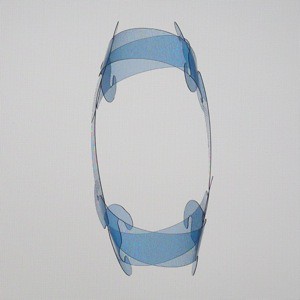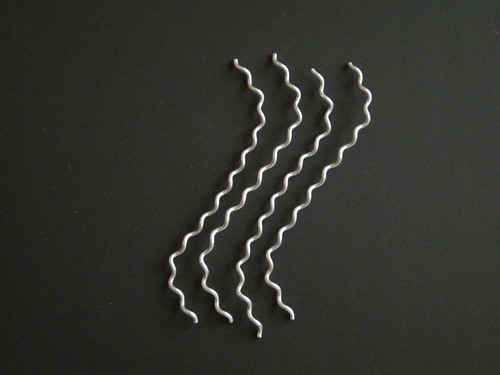Wednesday, October 6, 2010
Viable Adjacent Letter Mutations
In the tables below, all of the val mutations are summarized in truth table format. The first of the original adjacent letters labels the row, the second the column. The letters that will replace the two original letters are entries in the table, with e symbolizing deletion of both letters, and a blank entry indicating that no val mutation of that type (substitution, insertion, or deletion) can be made for those two letters.
Some other two-adjacent-letter edits may be viable in certain special contexts, for example insertion of the reversed spikes du and pn , but in the worst case, full context information would be needed to determine if the insertions are viable. In this sense, what are termed here val mutations are context-free.
Gene-Splicing Baskets
 |
| Starting with undp, an undip word for tetrahedrane, |
 |
| concatenate ud, an undip word for acetylene... |
 |
| ...and get undpud, or benzvalene. |
Insertion of undip words works just as well as concatenation. At any place in an undip word, insert another undip word and the result is a new undip word describing a hybrid shape. The new shape is 2-edge connected where the two original shapes are tenuously joined.
The structural weakness of this 2-edge join can later be healed by viable adjacent-letter (val) mutations. Val mutations are substitutions, insertions, or deletions of two adjacent letters that can be made without reference to context because they intrinsically satisfy the undip grammar rules.
Wednesday, September 29, 2010
Twongs Thronged at NY Maker Faire!
 |
| Visitors thronging the Twongs Table at the New York Maker Faire, September 25-26, 2010. |
 |
| That's me in orange. Some tried making the carbon chemistry models (annulenes) displayed in steel, but most went freeform. |
 |
| All ages advanced to level 101: having fun. |
 |
| The steel models wore their undip codes attached. |
 |
| Tetrahedrane in foreground, acetylene in back. |
Friday, September 17, 2010
Catalan Numbers and Baskets
How many undip words are there?
The famous Catalan numbers turn up in many places ( see "Exercises on Catalan and Related Numbers" and "Catalan Addendum" by Richard P. Stanley.) One of the classic examples is counting the number of ways 2n people seated around a table can simultaneously form n handshakes without crossings. The answer to this problem is the nth Catalan number. For example, the Catalan numbers for n = {0, 1, 2, 3, 4, 5} are {1, 1, 2, 5, 14, 42}.
Another set counted by the Catalan numbers are the number of words in the Dyck language that contain n pairs of parentheses. The Dyck language comprises all strings of open and close parentheses that follow the usual rules of arithmetic expressions. For example:
()
(()) ()()
((())) ()(())) (())() (()()) ()()()
etc.
The undip language is a shuffle of two Dyck languages: a {u,d} language and an {n,p} language. We can think of {u,d} as {(,)} and {n,p} as {[,]}, but unlike a Dyck language on two types of parentheses, in a shuffle of two Dyck languages the two types of parentheses ignore each other grammatically speaking. For example, a word such as:
( [ ) ]
is permitted.
R. Cori, S. Dulucq, and G. Viennot explain how the Catalan numbers are related to the planar hamiltonian cubic maps (the structures described by undip codes) in "Shuffle of Parenthesis Systems and Baxter Permutations," Journal of Combinatorial Theory, Series A 43, 1-22 (1986):
"...hamiltonian cubic maps are planar maps with a hamiltonian circuit in which all vertices have degree three. In such a map any vertex is incident with only one edge not in the hamiltonian polygon, this edge may be inside the polygon or outside. Thus to build a 'Hamiltonian rooted cubic map' one has to choose 2k vertices among the 2n (those incident with inside edges) then draw a planar map inside the polygon (it is easy to see that this can be done in Ck ways*) and a planar map outside."
*This is easy to see because it is essentially the handshaking problem.
A map is rooted by distinguishing a vertex and direction. In a hamiltonian circuit this is combinatorially equivalent to labeling all the vertices, since, given a direction and a place to start, we can reliably label the vertices with sequential integers. Working with a rooted map, every rotation of a pattern counts as a distinct pattern because the root occupies a different place in each rotation. Counting rooted maps exhaustively counts all of the possible undip codes even when they trivially encode the same shape by virtue of merely starting at a different location on the hamiltonian cycle.
Cori, Dulucq, and Viennot go on to show that the number of rooted hamiltonian planar cubic maps are counted by the product of two sequential Catalan numbers. For a hamiltonian circuit with 2n vertices the number of maps is the product of the nth Catalan number and the (n+1)th Catalan number.
Tthe number of undip words of length 2n for n= {1, 2, 3, 4, 5} are {2, 10, 70, 588, 5544}. This is sequence A005568 in the On-Line Encyclopedia of Integer Sequences (OEIS).
For better or worse, there are a great many more undip words than there are shapes to be described by them. Synonyms will abound.
Friday, September 10, 2010
O-Knitting
 |
| Making an o-knitting vertex, Step 1: Hold Needle upright. |
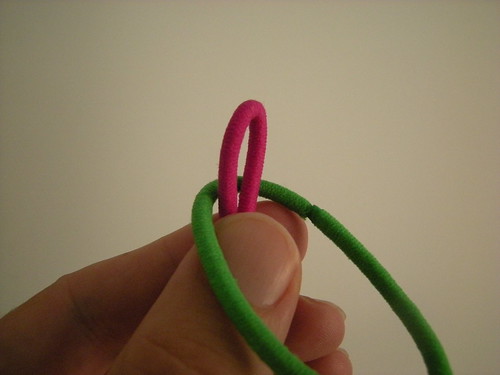 |
| Toss Quoit on Needle. |
 |
| Feed Thread through Needle. |
 |
| Pull Quoit through Thread. |
 |
| Voila! a completed vertex. |
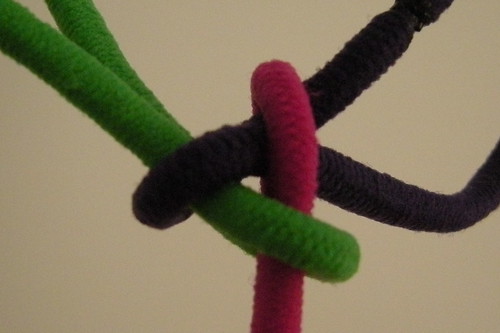 |
| Close-up of completed o-knitting vertex. |
Tuesday, August 31, 2010
Embedded graphs come in families of four
 |
| Cubic graph (the dual) |
 |
| Triangulation (the primal) |
 |
| Radial graph |
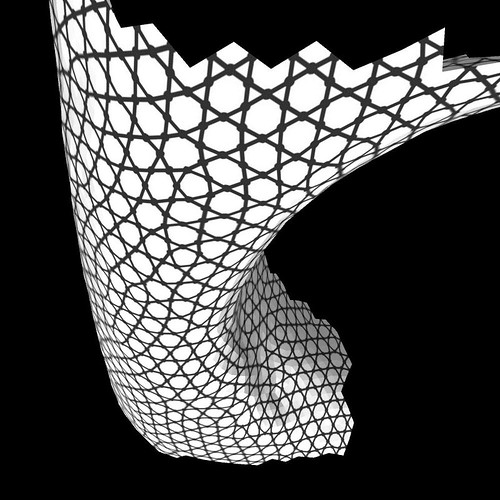 |
| Medial graph |
 |
| Kagome weave |
 |
| Anyam Gila |
Sunday, August 29, 2010
Undip codewords as lattice walks
Undip codes and Euler's Formula
Friday, August 27, 2010
What can undip codewords code?
Twongs and twogs can make more shapes than the four-letter undip code can code.
A graph must have a Hamilton circuit in order to be undip encoded. (Note that Hamiltonicity is a property of the graph, not the embedding.) That leaves out cubic graphs with self-loops (cubic pseudographs proper) since they can never be Hamiltonian. Only cubic multigraphs can be undip coded.
Furthermore, the embedding must be in the plane (or equivalently the sphere) in order for the coded side bonds to link up predictably. On a higher genus surface, the whole surface area might be encoded in the predictable planar way, but there will remain a closed curve (i.e., the polygon of the plane model, see A Combinatorial Introduction to Topology by Michael Henle) that cannot be seamed across without encountering a surprise.
The photo above shows a digonal prism. Even though a digonal prism is a graph embedded in the sphere, it is not considered a polyhedron by most definitions. For one thing, it contains two-sided faces (digons); for another, it is only 2-edge connected. (Cutting just the two edges shown vertical in the photo would separate the graph into two components.) Note that these are properties of the graph itself, not the embedding. Graphs that are only 1-edge or 2-edge connected make weak structures but they certainly are of sculptural interest. Polyhedron or not, 'udud' codes the digonal prism nicely.
Taking the adjective "plane" to mean "embedded in the plane or sphere," the undip code can encode Hamiltonian plane cubic multigraphs.
What can twongs make?
Twongs and twogs can make 3D embeddings of cubic pseudographs.
A graph is called cubic if three edges meet at each vertex. Simple graphs permit only a single edge to link two distinct vertices, multigraphs allow more than one edge to link two distinct vertices, pseudographs also allow a vertex to link to itself (i.e., form a self-loop.) A graph is an abstraction: a set of symmetrical relations (edges) between pairs of members of a set (the set of vertices). For example, the friendships (edges) between persons (vertices) listed in a phonebook. Such an abstraction has no geometry until we make some decisions not specified in the graph itself in order to place (embed) its vertices and edges in 3D space, or on the Euclidean plane, or on some other surface or in some other space. Sometimes a given graph can be embedded in a space in fundamentally different ways, e.g., a left-handed and a right-handed version. The embedding, not the graph itself, is our guide to these important practical details. See Topics in Trivalent Graphs by Marijke van Gans for a clear mathematical exposition.
If twongs and twogs are made long enough, they can be used to realize any 3D embedding of a cubic pseudograph. The construction above is an embedding of the smallest cubic pseudograph having loops. I call it loop-loop. An embedding of the smallest cubic pseudograph without loops (thus also a multigraph) is shown below. I call this one bang-bang.
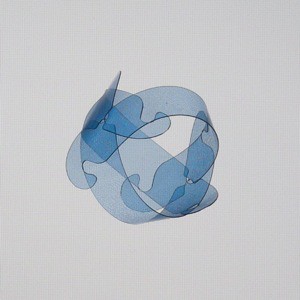
Sunday, August 15, 2010
twongs
These are what I call twongs.
A twong is a helical length of wire that has been bent in four places. Twongs are made by twisting up a pair of wires (these particular ones have been twisted to a helical wavelength of about 5 wire diameters), unravelling them, cutting them to length (these have been cut to a length of 12 helical wavelengths), and then bending. I have been working by hand, so I have been limited to 9 gauge (0.14 inch diameter) steel wire and smaller. Wire is made over a vast range of diameters, so twongs can be almost any size.
The main thing about twongs is that they twine together, three at a time, to form vertices. I've made a video about twining them together. With enough twongs you can make any shape having exclusively 3-valent vertices (three edges meeting at a vertex.) The tetrahedron, cube and dodecahedron are famous 3-valent (i.e., cubic) polyhedra, but there are many more. For example, there are 14,501 isomers of the dodecahedron, that is, different shapes but all with the same number of faces, vertices, and edges as the dodecahedron, and they are likewise all 3-valent. The C-60 buckyball is also all trivalent. Its isomers are effectively uncountable, being in excess of 10 to the 22nd. Yikes!
The are so many cubic polyhedra that, given enough vertices, we can use one to approximate any simple closed (i.e. genus zero) surface. The approximation is never smooth because all lengths are the same, nonetheless, there are many cases where a crinkly surface is a good enough, or where a crinkly surface can be made smooth by some mechanical process. In any case, the alternative--custom cutting every piece (I've tried it)--is a royal headache, and no custom-cut part is ever re-useable.

An astonishing thing about genus zero cubic graphs (let's just toss out the very small number that are non-Hamiltonian) is that they can be identified with words in a language having a very simple grammar. Formally the language is known as the shuffled Dyke language on two types of parentheses. Instead of parentheses we will want to use the following letters:
u, n, d, p
corresponding to (look at them tilting your head to the right) the following twiner's actions
"open left", "open right", "close left", and "close right"
The moves are as follows:
To start, pick up a very first twong and mark it with a twist-tie. This is insurance against getting lost--you can always retrace from the beginning if you know where that is. It also symbolizes that the very first twong is the work in progress. At any later vertex, at least one twong will be already part of the work in progress.
The first letter is always an "open" action, i.e., 'u' or 'n'. In an "open" action you just build a vertex--that's the same for "open left" or "open right." The difference comes when you exit the newly built vertex. To leave a twong "open (on the) left", we must build onto the right twong, Likewise to leave a twong "open (on the) right" we must build onto the left twong. That's all there is to 'u' and 'n,' they just tell us which way to go next.
Close actions require us to incorporate a previously placed twong into the current vertex. According to the letter, we are to look either to the left or the right for this previously placed twong. If there is more than one available on that side we simply choose the nearest one on that side (i.e., most recently placed). This is the same way nested parentheses close, hence the connection to parenthesis languages. Departing a close action is simple since only one of the three twongs will still have a free end.
The last vertex is always a close action. Implicitly, the first twong (the one marked by the twist tie) must be incorporated in this vertex along with the twong indicated by the final letter.
I have more about these "undip" codes in this year's Proceedings of the ISAMA.
Sunday, March 7, 2010
Knit Anything
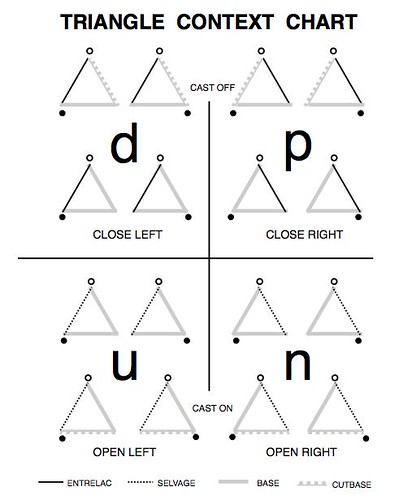
- The triangle is either an interior triangle or an exterior triangle (the only exterior triangles are the first, the cast-on triangle, and the last, the cast-off triangle.)
- The yarn enters either from left or right of the triangle base.
- The exterior edge of the triangle (i.e., the edge that is not interior to the triangle strip) is either a temporary selvage (open) or it is an entrelac (close), meaning it picks up stitches from the selvage of a previously knit triangle.
- The exterior edge is on the left or the right.
Tuesday, February 23, 2010
Proving Weaving
The Plain-Weaving Theorem
Akleman, Chen, Xing, and Gross (ACXG) have published a proof that every polygonal mesh describes a plain-weaving (a term to be precisely defined below.) If so inclined, we may count two plain-weavings by considering weavings differing only in textile handedness (indicated by the helical pattern of threads around a specified opening in the fabric) to be distinct.
(Note that any weaving can theoretically be everted—turned inside-out—through an opening. While this does not alter the textile handedness of the work, it does change the handedness of the work as a whole. For example, eversion turns a right hand glove into a left hand glove. So it may fairly be said that the everted version does not weave the same surface. Nonetheless, the same set of weavers, woven in the same handedness, may weave either surface. The basket maker will need a hint to resolve this ambiguity.)
ACXG's result is fundamental. Their proof is fully three-dimensional and topological, so there can be no objections as to its physical reality. The proof leaves no escape for a compact surface of any sort -- all compact surfaces, be they orientable or non-orientable, high-genus or low, are doomed to be woven as baskets. The escapees are the non-compact surfaces, i.e., surfaces of infinite extent, or infinite topological genus, or having excluded interior points or open boundaries—but such are not buildable by any method.
And there is also no escape for any particular kind of mesh. Their result, which I will take to calling the Plain-Weaving Theorem (PWT,) states that all polygonal surface meshes describe a way to weave the surface. There is great difficulty imagining any way to subdivide a surface into local neighborhoods that is not in effect a polygonal surface mesh. Admit it or not, computer scientists are doomed to be virtual basket weavers for the rest of history.
Having this 3D theorem in hand, I want to turn to a purely 2D representation of plain weaving which is easy to visualize, easy to characterize as a mathematical object, and probably sufficient for all artisanal purposes.
The Definition of Plain-Weaving
I adopt ACXG's definition of plain-weaving—which differs from common usage in the textile field. In their definition, a plain-weaving "consists of threads that are interlaced so that a traversal of each thread alternately goes over and under the other threads (or itself) as it crosses them." This definition takes in some weaves such as the kagome (also known as open hexagonal or triaxial) weave that are not considered "plain" in the textile field, but the PWT rewards us with the insight that all plain-weaves newly defined are really the same thing and can be intermixed freely.
Weaving and Chess-Colorings
Kenneth Snelson, in the specification of his patent on 3D weaving, U.S. Patent 6,739,937, makes a significant observation: we can treat weaving as a 2D arrangement of openings rather than a 3D arrangement of threads. To turn the old saw around, Snelson is saying we should watch the hole, not the donut.
As Snelson observes, the openings in a plain-weave fabric have a handedness that can be compared with the handedness of a screw-thread. In going from over-one-thread to under-the-next whilst going around an opening, the threads have a ramp-like geometry. If we arbitrarily choose a direction of travel around the periphery of the opening, and identify that direction with the direction of the curled fingers, then using the ramps in this direction converts the advancing movement into a motion in a perpendicular direction. We can identify this perpendicular direction with the direction of the thumb extended. Uniquely only a left or a right hand is capable of carrying both of these identifications. We can therefore unambiguously label every opening in a weave as right or left, R or L, or perhaps color code them black or white. Since no reference has been made to a side of the fabric, the handedness of the openings is intrinsic to the weaving: it matters not which side we view or whether the work is everted or not.
Also, there can be no question that the threads in a plain-weave agree on the handedness of any opening they share—otherwise they would not be able to reach a mutual arrangement about whose turn it is to go over or under where they cross. Like a circle of fallen dominoes, they must all lean one way.
Snelson observes that adjacent openings (i.e., openings on opposite sides of the same thread) have opposite handedness. This follows almost anatomically: if two hands have curled fingers pointing in the same direction, and extended thumbs pointing in the same direction, they surely must be a right and a left.
A coloring of the faces of a map with two colors, say black and white, such that adjacent faces have different colors is called a chess-coloring (I prefer this shorter term over "checkerboard coloring") Not all maps can be chess-colored, but a map operation, medialization, is known which converts any map into a chess-colorable map (Deza and Dutour.) The resulting map is called the medial of the original map (itself called the primal), and the result of medialization is the same whether we start from the primal map or its dual. In map operation notation (see Diudea et al. for an explanation of the notation):
Me(M) = Me(Du(M))
This is the result reported in ACXG that a mesh and its dual describe the same weaving. As Deza and Dutour have pointed out, medialization can be applied to any map (surface-embedded graph) to produce a chess-colorable map, hence every surface-embedded graph has a plain-weaving discoverable through this map operation.
In knot theory terms, a plain weaving is an alternating link. The medial graph is the projection (or more properly the shadow when crossing information is omitted) of an alternating link. The chess-coloring of the medial graph corresponds the checkerboard-coloring of the link projection, and the primal and dual maps above are the two Tait graphs of the link projection (see explanation of terms in Dasbach and Lowrance.) Because the link is alternating it is described in full by its chess-coloring.
Mathematically the study of plain-woven baskets reduces to the study of chess-colorings on surfaces, and such a chess-coloring contains essentially all the information the weaver needs to weave the basket.
References:
Akleman, E., Chen, J., Xing, Q., and Gross, J. L. 2009. Cyclic plain-weaving on polygonal mesh surfaces with graph rotation systems. ACM Trans. Graph. 28, 3 (Jul. 2009), 1-8. DOI= http://doi.acm.org/10.1145/1531326.1531384
Snelson, K., U.S. Patent 6739937, Space Frame Structure Made by 3D Weaving of Rod Members.
Deza, M., and Dutour, M., Zigzags and central circuits for 3- or 4-valent plane graphs, http://www.liga.ens.fr/~deza/Sem-ZigCc/ZigCcConf.pdf
Diudea, M., et al., 2003, Leapfrog and Related Operations on Toroidal Fullerenes, Croatia Chemica Acta, 76 (2) 153-159, http://pubwww.carnet.hr/ccacaa/CCA-PDF/cca2003/v76-n2/CCA_76_2003_153-159_diudea.pdf
Dasbach, O. and Lowrance, A. 2010. Turaev Genus, Knot Signature, and the Knot Homology Concordance Invariants, http://arxiv.org/pdf/1002.0898



